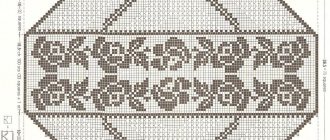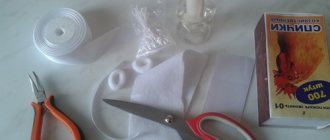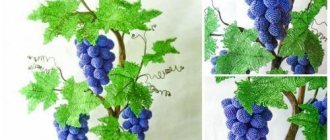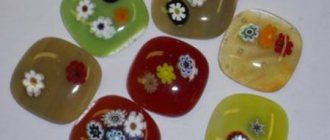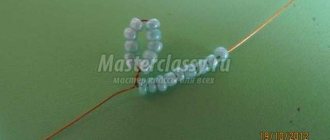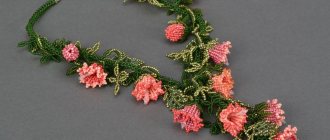Small bead products can be small but necessary souvenirs, original decorations and much more, wherever and whenever you want to use them. But the most important thing is that such crafts are very quick and easy to weave with your own hands. They don’t take much material at all, nor do they require much of your free time. In this article you will be offered patterns for weaving various fruits with a detailed description.
Weaving yellow banana from beads
You will need the following materials for your work: thin nylon thread, yellow and brown beads. So we begin to weave the first row, for which we will need two brown beads, which must be strung on a thread and placed in the center. According to the diagram, you need to complete rows two through nine, crossing the halves of the threads.
In order for the banana to have a curved shape, you will need to collect two yellow beads on each side of the thread in the tenth row, and then cross them with two other pieces of glass. In the eleventh strip, cross the main material again in two yellow beads, and then add one element to each side of the nylon thread and stretch them through the last beads of the tenth row. Pull the base so that you get a bulge.
The twelfth to eighteenth strip, as well as the nineteenth to twentieth stripe, should be woven in the same way as the tenth stripe. Carry out the same crossing with 21 r. 34 rubles each To make the tail of this exotic fruit, you will need to place two yellow and two brown beads on one side of the thread, then pull them together and tie knots, and the ends can be hidden between the rows. An interesting idea would be to make a ripe banana with your own hands. To do this, you just need to replace several light beads with dark ones in different places of the product.
Read
Spring primrose from beads in a step-by-step master class
Popular product - pomegranate
Pomegranate is a fruit that has very multifaceted symbolism.
It represents its color, shape and internal structure. The interior of the pomegranate embodies the principle of the integrity of the numerous and varied. In Ancient Greece, pomegranate meant fertility and success. According to the ancient Greeks, the grains of the fruit are drops of the blood of Dionysus, who was the god of fertility, which indicates integrity. Pomegranate is all living things among the Phoenicians, for whom it was an attribute of the god of the Heavenly Body. It is also mentioned in a number of sacred books of the Eastern tradition, including the Bible, where it appears as an image of beauty, as well as a symbol of the unity of the world.
It has healing properties, what influenced it? to be endowed with its status as a “divine” fruit. It is believed that the apple of Paris, Eve, the fruit of immortality in Scandinavian mythology is a pomegranate (an African variety of pomegranate that does not have seeds). Also used to create such a symbol of supreme power as a power; it is also possible that the crown was based on the jagged corolla at the top of the fruit.
Learning to weave a pear from beads
This beloved fruit is even easier to weave than a banana. Prepare the same materials for work, only use light green and also brown beads.
String one brown bead and leave it in the center. Weave according to the schematic pattern from the second to the twenty-first row, just like in the first option, crossing the nylon thread. String four dark-colored pieces of glass on the left side, as this will be the tail of the pear. Then pull the workpiece together. After this, stretch the main material as shown in the diagram. Pull the other part of the base through the first dark bead. Pull and tie a knot again, and cut off the excess ends or hide between the previously woven strips. That's it, this fruit is also completely done and quite quickly.
Assembling the composition
- The bouquet is assembled in this way:
- Berries and flowers are placed between the leaves.
- All elements of the bouquet are connected from below using floral tape.
- Place the finished composition in a prepared decorative pot of appropriate size. Now the unique berry and flower composition is ready.
In the process of creative work, needlewomen can create a product in their own way: increase or decrease the number of leaves, flowers. You can weave the leaves into other shapes. It all depends on your inspiration and imagination.
You can use this pot to decorate the interior of your home, or you can give it as a gift to family and friends who will definitely appreciate your creative work.
Weaving an exotic pineapple from beads
To weave this exotic fruit called pineapple, you will need the same nylon, as well as amber and green beads. String the amber glass and leave it in the center. Then weave from the second to the thirteenth row. according to the diagram, crossing the edges of the thread.
After this, we move on to making the first leaf. Place seven emerald elements on one side of the main material, and then pull it off and pull it in the opposite direction through two green beads. String three more of these elements, and then thread them through the beads located at the base of the leaf.
In the same way, weave 2 more pieces like this. The weaving technique is constantly repeated, so even beginners will be able to master such actions without getting confused. Add a few more leaves for this pineapple, then pull the base together, tie a knot, and trim off the excess ends.
Vegetables, fruits, berries made of beads
Businka January 05, 2014
Golden spikelets of wheat made from beads will be an excellent addition to a bouquet of wildflowers made from beads, and can also become an original independent composition. To make wheat ears you will need: - Beads of a light golden or honey shade; - Wire...
Read more →
biserok.org September 12, 2013 Grapes, Green, Blue, Complex, French technique
This beautiful bead work was made by Tatyana Ivanova. It is impossible to pass by such a masterpiece and I decided to add this MK to my website with the permission of the author. Many thanks to her! The necessary materials for work can be bought https://handmademart.net: - Beads No. 10 blue - Beads No. 10 ...
Read more →
biserok.org July 26, 2013 Grapes, Yellow, Mimosa, Loop technique, Simple, Purple
A very simple idea for weaving a bunch of grapes or mimosa; you can also weave a bunch of rowan berries, currants, and so on. This method is universal; you only need to change the color of the beads and the shape of the leaves. Necessary materials for weaving a bunch: - Violet or yellow opaque beads No. 10 - ...
Read more →
biserok.org May 14, 2013 Onion, Carrot, Parallel weaving, Pepper, Simply, Radish
How to weave vegetables As you can see, weaving and modeling carrots or onions is a completely simple task. After looking at all the diagrams, you will be able to understand the principle and independently draw up diagrams of other vegetables from tomatoes to potatoes. This diagram will help you. Necessary materials for...
Read more →
biserok.org May 11, 2013 Pineapple, Banana, Cherry, Pear, Strawberry, Raspberry, Parallel weaving, Simple, Currant
We weave simple beadwork After a cold winter, I really want fresh fruits and natural vegetables, so fragrant and rich in taste! Such small beaded trinkets can always remind you of summer and please the eye. All that remains is to choose what you love more and weave it for yourself...
Read more →
Svetlana Paykova (Nikolaeva) March 03, 2013 Pink, Hand weaving, Medium difficulty, Apple
Second master class on weaving an apple core This core differs not only in the color of the beads, but also in size. It is shorter by two rows, the leg is different, the leaf and shape are worked out according to a different pattern. Maybe you will like this option better, because I like it a lot! For this work I took: - Beads...
Read more →
Svetlana Paykova (Nikolaeva) March 03, 2013 Green, Hand weaving, Medium complexity, Apple
Master class on weaving from beads Once on the Internet I saw a beautiful apple core made of beads, it would be a keychain for a flash drive. I really liked it, but there was no diagram. Therefore, I decided to figure out how to weave it myself. This is my first work using hand weaving technique. The first experimental...
Read more →
biserok.org March 01, 2013 Green, Red, Parallel weaving, Simple, Bee, Medium difficulty, Fullerene, Apple
Volume apples Below is a diagram of weaving an apple based on four beads. To easily weave such a round fruit, I advise you to master the fullerene weaving technique. When you practice, this work will be very simple for you. A few more options for apples, but already five...
Read more →
biserok.org March 20, 2012 Simply
For the bell flower in Fig. 150 shows diagrams of the petal and stamens. Stamens can be made in another way - see the diagram in Fig. 153. To keep the flower in shape, stretch a thin wire through the longest rows of petals, close it into a ring, and hide the ends in adjacent rows. For toughness...
Read more →
Marshmelou February 04, 2012 Strawberry, Parallel weaving, Loop technique, Medium difficulty, French technique, Berries
Ripe strawberry-strawberry In today's Master Class I suggest you make a ripe strawberry in a pot that will decorate your home and will be ripe all year round. Beads are used to make strawberries. Our composition consists of the strawberry itself, its blossom and leaves. What …
Read more →
biserok.org
Patterns for weaving beaded fruits
Vegetables, fruits, berries made of beads
biserok.org March 01, 2010 Red, Raspberry, Beading, Simple, Berries
Raspberries from crystals Malinka You will need: 1.5 g of large or medium raspberry beads, 1.5 g of small green beads, a bead 7~9 mm in diameter, thread, needle, pin. The color of the bead does not matter, since it will hide inside the beaded case; even a damaged bead will do...
Read more →
biserok.org March 01, 2010 Barberry, Strawberry, Simple, Souvenirs, Berries
Multi-colored strawberries Beautiful and juicy strawberries are woven from crystals and beads. Barberry To work you will need large red oblong beads, green and black beads. Place a black bead in the middle of a 20-25 cm long wire and pass both ends of the wire through...
Read more →
biserok.org March 01, 2010 Watermelon, Mushroom, Pear, Yellow, Crystals, Simple, Souvenirs, Berries
Various fruits Weaving pattern: Yellow pear Fruit keychain. A clear pattern of weaving a bead product. Required materials: - yellow crystals - 5 green crystals - 3 brown crystals - fishing line or wire Such an interesting keychain...
Read more →
biserok.org March 01, 2010 Grapes, Crystals, Raspberries, Simply, Currants, Souvenirs, Berries
Raspberries and grapes Red currants You will need: 0.5 g of small green beads, 1 large green bead, 9 dark beads, 7 red round beads the size of currants, a pair of smaller pink or white beads, a pin, thread, needle. Thread the needle and fasten...
Read more →
biserok.org March 01, 2010 Brooches, Orchid, Parallel weaving, Simple, Cutting, Medium difficulty, Berries
Mother-of-pearl brooch Brooch “Apple Tree” Material: small chopped beads - 3 g green, 2 g each white and pink; 5 yellow and 5 green small beads, green threads to match the beads, wire, PVA glue, sewing needle or pin. Take 25-30 cm of wire and make a petal from white and...
Read more →
biserok.org February 15, 2010 Cherry, Strawberry, Simple, Souvenirs, Apple
Fruit figurines Parallel weaving technique. To work, you will need beads of the desired color, depending on the berry you decided to make, and the wire on which you will string the beads. Simple Weaving Pattern: Very cute and simple beadwork. Here you …
Read more →
biserok.org
Beaded berries - diagram, master class
It is also worth noting the importance of creating comfort in your home, so that as a result you have the opportunity to do handicrafts as efficiently as possible. First of all, the word comfort in modern civilization means warmth in your home, and by the way, on the page you will find a lot of useful information on how to make your home warmer at a very reasonable cost. ATM-TERM BOILER - MODERN ENERGY-SAVING TECHNOLOGIES AT YOUR HOME.
To make berries you need:
- green beads No. 10;
- raspberry beads No. 8;
- green floss threads;
- basket.
We string 4 crimson beads onto a wire 50 cm long, pass both ends of the wire through the three left beads and tighten the work
In the second row for the top tier, collect 4 beads and pass the other end of the wire along them.
For the lower tier, we collect 5 beads and thread them through the other end of the wire, tighten the work and place the row so that it is below the upper tier.
3rd row: top and bottom, 6 beads each.
4th row: top and bottom, 7 beads each.
5th row: top and bottom, 6 beads each.
The berry base is ready.
We weave a petiole to it: we collect 3 green beads on either end of the wire and pass the wire in the opposite direction through the first two beads.
We pull the resulting row closer to the berry and tighten the wire.
Using the same method, we make 3 more columns of green beads on this wire.
Now we repeat the work on another wire.
We attach these needles to the base of the berry.
We put one green bead on either end of the wire, secure it with the other end and place it exactly in the middle of the berry.
Using the same method, we string 1 bead on it 4 more times to form a petiole.
If this petiole is attached to the branch, then extend it by another 5 rows.
For each branch you need 3 berries.
Let's move on to weaving leaves: each leaf will consist of two halves, which will require a wire 30 cm long.
We weave the first half with parallel weaving according to the pattern: 11 (1, 2, 2, 3, 4, 5, 6, 5, 4, 3, 2).
When working, we attach the second sheet to the first and weave it according to the pattern: 10 (1, 2, 3, 4, 5, 5, 5, 4, 3, 2).
When the leaf is ready, twist the ends of the wire under it.
For one berry branch you need 5 such leaves.
We begin to form a branch from leaves: take the first leaf and wrap its petiole with green threads, then weave the next leaf to the work and another one on the other side. We continue wrapping the stem with threads.
Now you need to make one berry twig from three berries by twisting their ends together.
We screw the berries to the stem and continue to wrap it with green threads.
At a distance of 2-3 cm from the berries, screw another pair of leaves to the stem - the branch is ready.
We begin to assemble the composition: fill the basket with ready-made berries and place the finished twig there. Ready. Have a nice time!
biseroplet.ru
Preparatory stage
Try to stock up on the necessary materials and enough time in advance to make such a beautiful craft:
- green beads
- decorative sprigs of berries for creativity or large red beads
- wire 0.3 mm
- thickened wire for branches
- brown floral ribbon
- paints
- gypsum
- PVA glue
- acrylic lacquer
- matches
- rope
- oval stand

